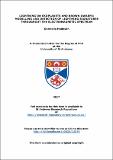Files in this item
Lightning on exoplanets and brown dwarfs
Item metadata
| dc.contributor.advisor | Helling, Christiane | |
| dc.contributor.author | Hodosán, Gabriella | |
| dc.coverage.spatial | 191 | en_US |
| dc.date.accessioned | 2017-11-14T09:39:33Z | |
| dc.date.available | 2017-11-14T09:39:33Z | |
| dc.date.issued | 2017-12-07 | |
| dc.identifier.uri | https://hdl.handle.net/10023/12079 | |
| dc.description.abstract | Lightning is an important electrical phenomenon, known to exist in several Solar System planets. Amongst others, it carries information on convection and cloud formation, and may be important for pre-biotic chemistry. Exoplanets and brown dwarfs have been shown to host environments appropriate for the initiation of lightning discharges. In this PhD project, I aim to determine if lightning on exoplanets and brown dwarfs can be more energetic than it is known from Solar System planets, what are the most promising signatures to look for, and if these "exo-lightning" signatures can be detected from Earth. This thesis focuses on three major topics. First I discuss a lightning climatology study of Earth, Jupiter, Saturn, and Venus. I apply the obtained lightning statistics to extrasolar planets in order to give a first estimate on lightning occurrence on exoplanets and brown dwarfs. Next, I introduce a short study of potential lightning activity on the exoplanet HAT-P-11b, based on previous radio observations. Related to this, I discuss a first estimate of observability of lightning from close brown dwarfs, with the optical Danish Telescope. The final part of my project focuses on a lightning radio model, which is applied to study the energy and radio power released from lightning discharges in hot giant gas planetary and brown dwarf atmospheres. The released energy determines the observability of signatures, and the effect lightning has on the local atmosphere of the object. This work combines knowledge obtained from planetary and earth sciences and uses that to learn more about extrasolar systems. My main results show that lightning on exoplanets may be more energetic than in the Solar System, supporting the possibility of future observations and detection of lightning activity on an extrasolar body. My work provides the base for future radio, optical, and infrared search for "exo-lightning". | en_US |
| dc.language.iso | en | en_US |
| dc.publisher | University of St Andrews | |
| dc.relation | Hodosán, G.; Helling, Ch.; Asensio-Torres, R.; Vorgul, I. & Rimmer, P. B., 2016, Monthly Notices of the Royal Astronomical Society, 461, 3927 | en_US |
| dc.relation | Hodosán, G.; Rimmer, P. B. & Helling, Ch., 2016, Monthly Notices of the Royal Astronomical Society, 461, 1222 | en_US |
| dc.relation | Hodosán, G., Helling, Ch., & Vorgul, I.; Submitted to the Monthly Notices of the Royal Astronomical Society (Feb. 2017) | en_US |
| dc.relation | Hodosán, G.; Rimmer, P. B. & Helling, Ch., submitted to the Conference proceedings of the 8th International Workshop on Planetary, Solar and Heliospheric Radio Emissions (PRE 8), held in Seggauberg near Leibnitz/Graz, Austria, October 25−27, 2016 | en_US |
| dc.rights | Attribution-NonCommercial-NoDerivatives 4.0 International | * |
| dc.rights.uri | http://creativecommons.org/licenses/by-nc-nd/4.0/ | * |
| dc.subject | Exoplanets | en_US |
| dc.subject | Brown dwarf | en_US |
| dc.subject | Atmospheric electricity: lightning | en_US |
| dc.subject | Solar System: Earth, Venus, Jupiter, Saturn | en_US |
| dc.subject | Comparative planetology: modelling, observations | en_US |
| dc.subject.lcc | QB820.H73 | |
| dc.subject.lcsh | Extrasolar planets | en |
| dc.subject.lcsh | Brown dwarf stars | en |
| dc.subject.lcsh | Atmospheric electricity | en |
| dc.title | Lightning on exoplanets and brown dwarfs | en_US |
| dc.title.alternative | Modelling and detection of lightning signatures throughout the electromagnetic spectrum | en_US |
| dc.type | Thesis | en_US |
| dc.type.qualificationlevel | Doctoral | en_US |
| dc.type.qualificationname | PhD Doctor of Philosophy | en_US |
| dc.publisher.institution | The University of St Andrews | en_US |
The following licence files are associated with this item:
This item appears in the following Collection(s)
Except where otherwise noted within the work, this item's licence for re-use is described as Attribution-NonCommercial-NoDerivatives 4.0 International
Items in the St Andrews Research Repository are protected by copyright, with all rights reserved, unless otherwise indicated.


